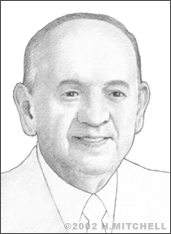George Heilmeier
Liquid crystal scientist George H. Heilmeier was born in 1936 in Philadelphia. He earned a BS in Electrical Engineering from the University of Pennsylvania and then moved on to Princeton where he earned MA, MSE, and PhD degrees in solid-state electronics. Soon after graduation, he joined RCA Laboratories, where his work on various electronic and electro-optic devices led to his promotion to Head of Solid State Device Research in 1966.
Heilmeier was working at RCA’s David Sarnoff Research Center in 1963 when he and Richard Williams published a report suggesting the use of liquid crystal materials for display. Heilmeier and a lab group including Nunzio Luce, Louis Zanoni, Joel Goldmacher, Joseph Castellano, and Lucian Barton began investigating the use of liquid crystal displays for a television concept. The group realized that LCD (liquid crystal display) TVs were many years off, so they concentrated on developing the digital time display for clocks and watches. Some of the team left RCA to form Optel Corporation, a company that produced LCD watches for several watch companies and later marketed LCD watches under its own name.
Heilmeier’s liquid crystal displays used dynamic scattering method, or DSM, a process in which an electrical charge is applied, which rearranges the molecules so that they scatter light. These were replaced by an improved version, invented by James Fergason in 1969, which used the twisted nematic field effect of liquid crystals. Heilmeier is credited with setting the ball in motion for the use of LCDs in calculators, watches, computers, and other instruments. In 1968, he was recognized by RCA with its prestigious David Sarnoff Award.
In 1970, Heilmeier was chosen as a White House Fellow to work on research, planning, and technology assessment for the Secretary of Defense. The following year, he was named Assistant Director of Defense Research and Engineering, in charge of all Department of Defense programs in electronics, computer technology, and physical sciences. In 1975, he became the Director of the Defense Advanced Research Projects Agency (DARPA), where he managed projects including stealth aircraft, lasers, and artificial intelligence. While working for DARPA, he was twice awarded the Department of Defense Distinguished Civilian Service Medal, the highest civilian award given by the department.
Heilmeier left DARPA in 1977 to join Texas Instruments. There he managed research and development projects in petroleum exploration, systems technology, microelectronics, and software. He was appointed Vice President of Corporate Research, Development, Engineering, and Strategic Planning in 1978 and was named Senior Vice President and Chief Technical Officer in 1983.
In 1991, Heilmeier was elected president and CEO of Bellcore, formerly Bell Communications Research, a research and engineering consortium owned by the seven regional Bell operating companies. He later focused on coordinating efforts to develop a national information infrastructure that he said would bring interactive media into users’ homes by linking telephones, computers, and television to produce video, sound, and data. Over the course of his career, Heilmeier earned 15 patents and received numerous awards, including the National Academy of Engineering Founders Award (1991), the National Medal of Science (presented by President Bush in 1991), the John Scott Award for Scientific Achievements from the City of Philadelphia (1996), the IEEE Medal of Honor (1997), and the John Fritz Award (1999).
Additionally, Heilmeier was a member of the Defense Science Board, the National Security Agency Scientific Advisory Board, and the Board of Directors of companies including TRW, the MITRE Corporation, Compaq Computer Corporation, INET Inc., Teletech Holdings, and Automatic Data Processing (ADP) Corp. He was also a member of the National Academy of Engineering and a fellow of the IEEE and the American Academy of Arts and Sciences.
Heilmeier died of a stroke in 2014 at the age of 77.


